The art of storytelling is as old as humanity itself. From the time our hunter-gatherer ancestors sat around the fire regaling each other with epic hunting missions to modern cinematic showcases like Pat Boonnitipat’s wildly popular tearjerker How to Make Millions Before Grandma Dies, storytelling has served as a powerful tool for communication, cultural preservation, and emotional connection.
 Shyan Tan
Shyan Tan
As Singaporean cinematographer Shyan Tan notes, storytelling transcends mere documentation; it serves as a portal connecting characters with audiences. As much as possible, Tan infuses his projects – which encompasses everything from interactive short films directed by Royston Tan and music videos for Nathan Hartono to commercials shot for Temasek Foundation, the CPF Board, and HSBC – with plenty of narrative and emotion.
“I tend to gravitate towards stories that are grounded in reality and feature characters with a lot of inner conflict. There’s something about those real, messy human emotions that I find incredibly compelling,” shares the recipient of the 2023 National Arts Council's Young Artist Award, a prestigious accolade that recognises outstanding artistic achievements among young (under-35) arts practitioners. Tan is the first cinematographer to receive the award.
(Related: Forging Legacies - Setting the stage for success)
 Jolinna Ang, photo by Zulfadli bin Rahman, assisted by Marcus Lim
Jolinna Ang, photo by Zulfadli bin Rahman, assisted by Marcus Lim
Jolinna Ang, a rising cinematographer and mentee of Shyan Tan, was inspired to pick up the craft because of the power of cinema. Ang is carving her own path in the industry, having recently completed her first feature film in Sabah, called Wilderness. A member of the Singapore Society of Cinematographers, Ang has already made her mark through a series of short films and advertisements, with a focus on narrative-driven projects. It was her father who introduced her to the world of cinema; watching films was something the pair did together.
“I vividly remember an incident, where we were watching a movie by Steven Spielberg, called A.I. (Artificial Intelligence),” she shares. “Towards the end, I heard sobs coming from beside me. I turned and saw my father tearing. That was the second time I had ever seen him cry. The first was when his mother died. At that moment, films became more than just entertainment. I felt the power of cinema. Ever since, I took it as my calling to be a storyteller.”
Tan, on the other hand, found his calling unexpectedly. Initially a science student, he never envisioned a career in the arts until a chance encounter with his junior college physics teacher changed everything. “One day, my teacher needed assistance in photographing a school event and chose me for the task,” he recalls.
“As my teacher was a passionate photographer, he took the time to teach me the fundamental operations of the camera, and also provided guidance on composition and lighting.” This experience ignited his passion for visual storytelling, leading him to explore the cinematic world through films like Wong Kar Wai's In the Mood for Love, a film that deeply resonated with him because of its “exceptional cinematography”.
(Related: Transformative mentorships perpetuating artistic heritage)
- THE FORGING OF CREATIVE BONDS
- OVERCOMING HURDLES TOGETHER
- SEEING THINGS THROUGH A DIFFERENT LENS
The forging of creative bonds
Tan and Ang’s relationship began in 2016 on the set of a children's drama, where Ang served as Tan’s first camera assistant. Over the course of their 30-day shoot, they bonded over their aspirations and love for film. “We had plenty of time to talk about films and our aspirations,” Tan recalls.
Their shared passion for filmmaking quickly blossomed into a friendship grounded in mutual respect and a shared vision. Tan recognised Ang’s sensitivity toward performance and lighting, qualities that would define her as a cinematographer. This connection laid the foundation for a mentor-protégé relationship that would evolve over the years.

“Whenever she encounters problems on set, or she needs somebody to bounce off ideas, I would be there to guide and advise her.”
As Ang transitioned to a full-time cinematographer in 2019, Tan became a crucial source of support and guidance. “Whenever she encounters problems on set, or she needs somebody to bounce off ideas, I would be there to guide and advise her,” he explains. Their relationship deepened beyond professional boundaries, with Ang becoming a close personal friend and even spending time with Tan’s family. “I can say she is like a sister to me now. We would often have watch parties, where we watch each other’s works and critique them,” Tan adds.
- THE FORGING OF CREATIVE BONDS
- OVERCOMING HURDLES TOGETHER
- SEEING THINGS THROUGH A DIFFERENT LENS
Overcoming hurdles together
Both Tan and Ang have faced significant challenges in their careers. For Tan, establishing his name in a competitive industry required a mix of luck and relentless hustling. “I did free shoots, helped out on different sets for little-to-no pay, just to get my name around,” he explains. He also acknowledges the delicate balance between pursuing independent film projects and securing a stable income, a struggle familiar to many filmmakers in Singapore.
Ang has encountered unique challenges as a young female cinematographer, often finding herself typecast in storytelling roles. “Opportunities don’t come easily [for] any young cinematographer, regardless of gender and race,” she admits.
However, she remains optimistic about the industry's evolving landscape, noting that opportunities are becoming more diverse and inclusive. Tan’s mentorship has been instrumental in helping her navigate these challenges, advocating for her abilities and opening doors in an industry that has historically been male-dominated. “He is constantly advocating for me. He definitely opened doors for me in a time when not a lot of people did,” Ang reflects.
- THE FORGING OF CREATIVE BONDS
- OVERCOMING HURDLES TOGETHER
- SEEING THINGS THROUGH A DIFFERENT LENS
Seeing things through a different lens

“Every time we watch something, we will look at it as an audience and then slowly break down what is good and what could be improved from it.”
The mentor-protégé dynamic between Tan and Ang is characterised by mutual growth. Tan acknowledges that mentoring Ang has enriched his own understanding of filmmaking, particularly in recognising how different perspectives – especially those influenced by gender – can shape storytelling.
“One significant lesson I've learned is the inherent differences in how individuals of different genders may perceive the same story,” he shares. This awareness has made him more deliberate in his approach, striving to create narratives that resonate with diverse audiences.
Their watch parties and critique sessions have become a cornerstone of their relationship, providing opportunities for candid discussions about their work. “Every time we watch something, we will look at it as an audience and then slowly break down what is good and what could be improved from it,” Ang explains. These moments of reflection allow them to challenge each other's artistic choices and expand their perspectives.
As Tan and Ang navigate their respective paths, they remind us all that the journey of storytelling is as important as the stories themselves. At the same time, their shared journey reflects the challenges and triumphs of navigating the film industry, highlighting the importance of collaboration, open communication, and mutual support.







 Shyan Tan
Shyan Tan
 Jolinna Ang, photo by Zulfadli bin Rahman, assisted by Marcus Lim
Jolinna Ang, photo by Zulfadli bin Rahman, assisted by Marcus Lim







 Back
Back
